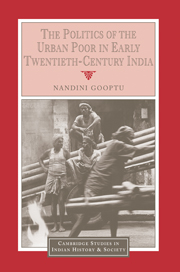Book contents
- Frontmatter
- Dedication
- Contents
- List of tables
- Acknowledgements
- List of abbreviations
- Select of glossary
- 1 The study and its perspectives
- Part I Changing contitions and experiences in interwar north India
- 2 The poor in the urban setting
- 3 Urban local policies and the poor
- 4 Urban policing and the poor
- Part II Modes of political action and perception
- Bibliography
- Index
2 - The poor in the urban setting
from Part I - Changing contitions and experiences in interwar north India
Published online by Cambridge University Press: 05 July 2014
- Frontmatter
- Dedication
- Contents
- List of tables
- Acknowledgements
- List of abbreviations
- Select of glossary
- 1 The study and its perspectives
- Part I Changing contitions and experiences in interwar north India
- 2 The poor in the urban setting
- 3 Urban local policies and the poor
- 4 Urban policing and the poor
- Part II Modes of political action and perception
- Bibliography
- Index
Summary
In the economy and society of north India, the function of towns as well as the relation of social groups within urban areas had been slowly, but decisively, changing fromthe late eighteenth century. As Christopher Bayly's study of north India in the eighteenth and nineteenth centuries has shown, successive reorientations in state power and the accompanying reconfiguration of social forces wrought profound transformations in urban forms. From the middle of the eighteenth century, the gradual decline of the Mughal empire, the rise of regional ‘successor’ states, and the decentralisation of royal power accelerated the development of towns primarily as centres of elite consumption and trade and as the seats of a ‘rooted service gentry’ and of ‘a homogeneous merchant class’, to use Bayly's terms. The growth of trade and towns in this period was partly stimulated by the rise in agrarian production and commerce in response to the more rigorous extraction of land revenue by the regional regimes. This was coupled with an accelerating export trade in products such as cotton, indigo and opium. Urbanisation was also partly related to the expanding consumption demands of both the increasing number of town-based service elites involved in revenue administration and the aristocracies of the regional polities. Consumption demands boosted the intermediate economies of transport services, local trade and artisanal production. Increasingly active and buoyant merchant communities came to provide the infrastructure for this economic transition and the growth of towns.
- Type
- Chapter
- Information
- Publisher: Cambridge University PressPrint publication year: 2001

